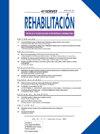物理康复计划对截肢患者体温对称性、活动能力、功能和步态的影响
Q3 Medicine
引用次数: 0
摘要
康复中心为截肢者提供专门的项目,旨在提高他们的功能能力和生活质量。本研究旨在评估以医院为基础的康复计划对下肢截肢患者下肢皮肤温度分布、活动、功能和步态的影响。材料和方法这是一项实验性、纵向、观察性研究,对14名住院强化康复患者进行干预前和干预后评估。在多学科物理康复计划前后,用红外热像仪(FLIR T650SC®)评估大腿、膝盖和腿部的皮肤温度,用Timed Up and Go、截肢者活动能力测试预测器(AMP)和2分钟步行测试测试活动、功能和步态。根据数据分布,对基线和干预后数据进行Student’st检验或配对数据的Wilcoxon检验。α水平设为5%。结果两组患者的基线体温与干预后体温比较均无明显变化。平衡(AMP评分由32±7.10分提高至35.07±6.76分;p & lt;0.0001),步态(2-MWT距离73.14±52.87 m ~ 96.57±60.91 m;p = 0.004),功能(TUG总时间由27.14±22.68 s降至16.82±10.09 s;p & lt;0.001)。结论下肢截肢患者在肢体康复治疗后,在活动能力、功能和步态方面均有改善,但在下肢皮肤温度分布方面无明显变化。本文章由计算机程序翻译,如有差异,请以英文原文为准。
The effect of a physical rehabilitation program on temperature symmetry, mobility, functionality and gait in amputee patients
Introduction
Rehabilitation centers offer specialized programs for amputees aimed at enhancing their functional abilities and quality of life. This study aimed to evaluate the impact of a hospital-based rehabilitation program on lower-limb skin temperature distribution, mobility, functionality and gait in individuals with lower-limb amputations.
Material and methods
This is a pilot, longitudinal, observational study, with pre–post-intervention assessments of 14 patients admitted for inpatient intensive rehabilitation program. The skin temperature of the thigh, knee, and leg was evaluated with an infrared thermography camera (FLIR T650SC®), and mobility, functionality and gait were tested with the Timed Up and Go, Amputee Mobility test Predictor (AMP), and the 2-minute walk test, before and after the multidisciplinary physical rehabilitation program. The baseline and post-intervention data were compared with the Student's T-test or Wilcoxon test for paired data according to data distribution. The α level was established at 5%.
Results
The comparison of baseline and post-intervention temperature outcomes showed no significant changes regardless of the side. There was a significant improvement in balance (AMP scores from 32 ± 7.10 to 35.07 ± 6.76; p < 0.0001), gait (2-MWT distance 73.14 ± 52.87 m to 96.57 ± 60.91 m; p = 0.004), and function (TUG total time from 27.14 ± 22.68 s to 16.82 ± 10.09 s; p < 0.001).
Conclusion
This study demonstrated that individuals with lower limb amputees experienced improvements in terms of mobility, functionality and gait after the physical rehabilitation program, however, they did not have significant changes in relation to the distribution of skin temperature between the lower limbs.
求助全文
通过发布文献求助,成功后即可免费获取论文全文。
去求助
来源期刊

Rehabilitacion
Medicine-Rehabilitation
CiteScore
0.80
自引率
0.00%
发文量
63
期刊介绍:
La revista que es desde hace más de 40 años la publicación oficial de la Sociedad Española de Rehabilitación y referente de la mayoría de las Sociedades de la Especialidad de los países americanos de habla hispana. Se publican 5 números pluritemáticos al año y uno monográfico sobre un tema del mayor interés y actualidad designado por el consejo de redacción.
 求助内容:
求助内容: 应助结果提醒方式:
应助结果提醒方式:


